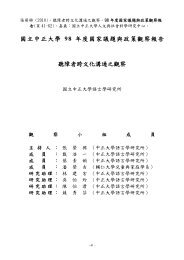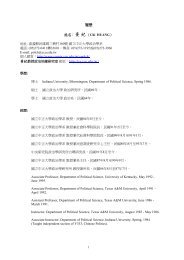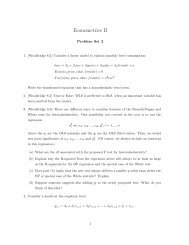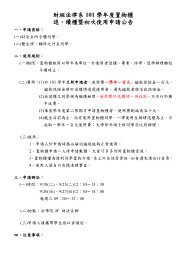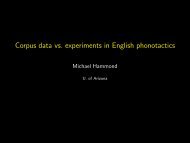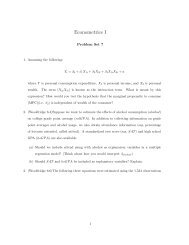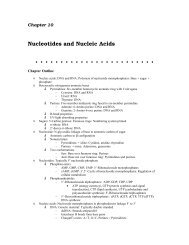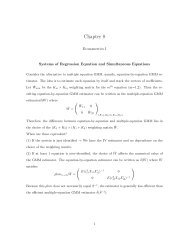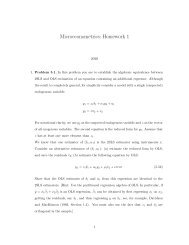Slides
Slides
Slides
You also want an ePaper? Increase the reach of your titles
YUMPU automatically turns print PDFs into web optimized ePapers that Google loves.
"The acquisition of syntactic categories in Chinese:<br />
issues of bootstrapping and productivity" *<br />
Thomas Hun-tak Lee, Chinese University of Hong Kong<br />
Email: huntaklee@cuhk.edu.hk<br />
International Workshop on Grammar & Evidence<br />
National Chung Cheng University, Taiwan<br />
April 13-15, 2007<br />
1. Two contrasting positions on the acquisition of syntactic categories<br />
1.1 The nativist position: the Universal Category Hypothesis (Chomsky 1965,<br />
1970, Jackendoff 1977, Wexler and Culicover 1980)<br />
The nativist position as enunciated in Chomsky (1965), termed the Universal<br />
Category Hypothesis by Culicover (1999), assumes that syntactic categories such as<br />
nouns, verbs, adjectives and prepositions are drawn from the substantive universals of<br />
Universal Grammar, understood to be part of the initial state of the child. These<br />
categorial primitives can be further analyzed as features within the framework of<br />
X-bar theory (Chomsky 1970, Jackendoff 1977, Baker 2003) .<br />
Given language variation, what is hardwired are just the formal category labels, and<br />
not the particular cluster of properties that define them. To bootstrap into the syntax of<br />
their target language, children must figure out the distributional characteristics of the<br />
various syntactic categories of the language.<br />
This boostrapping task could not be accomplished without some built-in biases, such<br />
as the learner's assuming canonical mappings between syntactic categories and the<br />
prototypical meanings of their members, as postulated in the Semantic Bootstrapping<br />
Hypothesis of Pinker (1987).<br />
1.2 The empiricist position: the Contingent Category Hypothesis (Braine 1963,<br />
Bowerman 1976, Maratsos and Chalkley 1980, Culicover 1999, Tomasello 2003)<br />
The empiricist hypothesis on category acquisition, termed the Contingent Category<br />
Hypothesis by Culicover (1999), does not assume innately given syntactic primitives.<br />
Children learn the distributional characteristics of various syntactic categories<br />
inductively, using information such as morphological marking, word order and<br />
semantic/ conceptual primitives.<br />
*<br />
I am indebted to various members of the Hunan Chinese Early Language Acquisition group who contributed to<br />
the recording of the data of two subjects: LSY and AJR, and the transcription of the recordings: Ai Zhaoyang,<br />
Zeng Tao, Huang Aijun, Chen Min, Cai Xin, Chen Feiyan, Liao Hui, Xiao Ling and Yang Jie. Thanks are also due<br />
to Wang Hao for his technical support in the data processing for distributional analysis. We owe special thanks to<br />
Ning Chunyan for his staunch support of acquisition research at Hunan University. The research reported in this<br />
paper was supported by two grants to Thomas Lee, a Research Grants Council grant (CityU 1245/02H), and a<br />
faculty start-up grant of the Chinese University of Hong Kong.<br />
1
In theory, language could vary without limit in the way word classes are formed and<br />
in the features utilized to encode the category. A language may have major categories<br />
with a large membership, such as nouns and verbs, as well as idiosyncratic minor<br />
categories or sub-categories consisting of very few members. The set of syntactic<br />
categories in human language is potentially unbounded.<br />
Empiricist views on the acquisition of syntactic categories have had a long history,<br />
going back to the early pivot grammar of Braine (1963), the limited scope forumulas<br />
of Braine (1976), the semantic-based proposals of Bowerman (1973) and Schlesinger<br />
(1982), the semantic-distributional analysis of Maratsos and Chalkley (1980),<br />
Maratsos (1982), the inductive learning account of MacWhinney (1982) that takes<br />
into account the function of rote-learning, analogy and item-based patterns; and the<br />
more recent usage-based proposal of Tomasello (1992, 2000, 2003) which argue for<br />
the predominance of lexically based patterns rather than abstract categories in early<br />
development.<br />
Very Early Parameter Setting (VEPS): "From the earliest observable ages (around<br />
18 months), children have set their parameters correctly." (Wexler 1998, 2003)<br />
'Do young children have adult syntactic competence" (Tomasello 2000):<br />
"...the 2-year-old child's syntactic competence is comprised totally of verb-specific<br />
constructions with open nominal slots. Other than the categorization of nominals,<br />
nascent language learners possess no other linguistic abstractions or forms of<br />
syntactic organization." (Tomasello 2000:214)<br />
1.3. Arguments in favor of the Universal Category Hypothesis<br />
• Inherent circularity in the definition of syntactic categories (cf. Pinker 1987).<br />
Criteria for the English determiner (Valian 1986):<br />
a) Must appear, if present in NP, pre-Adj or pre-Noun or pre-both.<br />
b) Must not stand alone as sole content of an utterance or phrase.<br />
c) Must not be sequenced (exceptions: certain quantifiers).<br />
Criteria for the Cantonese classifier (Wong 1998:58)<br />
a) A classifier can occur immediately after a determiner, a numeral, or a VP.<br />
b) A classifier usually occurs immediately before a noun or an adjective modifying the<br />
head noun.<br />
c) A classifier can occur immediately before an adjectival phrase or relative clause.<br />
• A purely item-based distributional account will involve astronomical computations<br />
Caveat: The learner may not consider all combinations of words out of other<br />
constraints such as processing limitations; the idea of 'less is more' of Elissa Newport<br />
2
(1990). The computations will be reduced if frequency effects are taken into<br />
consideration (Mintz, Newport and Bever 1995; Mintz 2003).<br />
• UG principles make reference to syntactic categories (Lasnik 1990)<br />
• The early acquisition of functional categories and core syntactic structures in early<br />
child language. The issue of continuity in language development.<br />
Knowledge of inflectional categories by two years of age (Poeppel and Wexler 1993,<br />
Wexler 1998, 2003; Pierce 1992; Deprez and Pierce 1993).<br />
Knowledge of structure-dependence by three years old (Crain and Nakayama 1987)<br />
Knowledge of numerous subtle properties of grammar (Constraints on<br />
wanna-contraction, and Principle A and Principle C of the Binding Theory)<br />
(see Crain 1991, Crain and Thornton 1998 for a review of relevant studies; also Chien<br />
and Wexler 1987, 1990).<br />
2. What counts as evidence for category acquisition<br />
Typically the advocates of UCH and CCH do not use the same criteria for category<br />
acquisition, or the same kinds of data, and often ignore the crucial evidence produced<br />
by the other side.<br />
Tomasello (2000).<br />
Crain vs Tomasello debate at BU Conference on Language Development (2004).<br />
Linguists do not have a consensus on the kinds of criteria that count as decisive<br />
evidence for children's knowledge of syntactic categories.<br />
2.1 Observance of category distribution in adult language<br />
Table 1. Determiner use by two-year-old English children (Valian 1986)<br />
Child Age MLU Utterances Tokens *post-adj *alone *two<br />
/utterance or<br />
Dets in<br />
*post-N<br />
sequence<br />
A 2;0 2.93 420 .36 0 0 0<br />
D 2;3 3.21 532 .50 0 0 1<br />
I 2;5 3.31 200 .37 0 0 0<br />
S 2;5 3.47 689 .30 0 0 0<br />
E 2;5 3.58 358 .36 0 0 0<br />
N 2;0 4.14 52 .42 0 0 0<br />
Example 1: Determiners in English (Valian 1986)<br />
3
A study of 6 English-speaking children aged between 2 years and 2 years 5 months,<br />
with MLU ranging from 2.93 to 4.14.<br />
Example 2: Modal auxiliaries in English (Valian 1991)<br />
A study of 21 American children aged between 1;10 and 2;8, divided into 4 age<br />
groups, the youngest group having the mean age of 2;0 and mean MLU 1.77, and the<br />
oldest group having the mean age of 2;7 and MLU 4.22.<br />
All children except the lowest MLU child produced modal auxiliaries. In every group,<br />
'can' and 'll/will' were the two most common modals.<br />
Modal usage was infrequent: in Group I, only 3% of utterances with verbs contained<br />
modals, a total of 14 tokens. There was a steady gradual increase to 6% in Group II<br />
(61 tokens), 9% in Group III, and 14% in Group IV.<br />
Valian argued that Group I children have knowledge of modals as a category separate<br />
from verbs, ie. knowledge of INFL.<br />
"First appearance correlates highly with more stringent criteria...Sampling<br />
considerations alone would suggest that a child has been using a form before our data<br />
demonstrate it. ....At present any criterion beyond initial correct use appears arbitrary.<br />
Since the Group I children made no distributional errors with the modals they used,<br />
we have called their use genuine." (p. 60)<br />
Example 3: Finite vs nonfinite distinction of verbs in Dutch<br />
Table 2. Verb use by Dutch children (aged 1;7-3;7; N=47) (Wexler 2003)<br />
All normal children V2 Vfinal<br />
Finite 1953 (99%) 11 (2%)<br />
Non-finite 20 (1%) 606 (98%)<br />
"Very little leeway has to be given to measurement error or noise, even at the<br />
youngest ages. This is the kind of data that psychologists studying cognitive<br />
development almost never see, close to categorical data." (Wexler 2003)<br />
2.2 Pre-requisite for distributional analysis: demonstrating the productivity of<br />
early word combinations<br />
How to analyze a multiword utterance W1 W2<br />
(a) W 1+2<br />
(frozen form)<br />
(b) W1+W2<br />
(genuine word combination)<br />
(c) Category1 + Category2 (category sequence)<br />
4
Explicit coding scheme for measuring productivity of multiword utterances:(Lieven,<br />
Pine and Barnes 1992, Lieven, Pine and Baldwin 1997).<br />
Frozen phrases: utterances which contain two or more words which have not<br />
previously occurred alone in the child's vocabulary or which contain one such word,<br />
provided it has not occurred in the same position in a previous multi-word utterance.<br />
Constructed utterances: utterances which contain one or more words or phrases which<br />
have occurred independently in the child's vocabulary together with a word or phrase<br />
which has occurred in the same position in at least two other previous multi-word<br />
utterances.<br />
Example:<br />
Words in child's single-word vocabulary:<br />
Gone<br />
ball<br />
dolly<br />
birdie<br />
dinner<br />
Multi-word utterances:<br />
book gone<br />
ball gone<br />
dolly gone<br />
birdie gone<br />
dinner gone<br />
frozen phrase<br />
intermediate<br />
constructed<br />
constructed<br />
constructed<br />
Lexically-based constructions can account for about 60% of children's early<br />
multi-word utterances, with the remainder 40% consisting primarily of frozen phrases<br />
(Lieven, Pine and Baldwin 1997).<br />
Acquiring a stock of frozen phrases may be a typical route for syntactic acquisition<br />
(Pine and Lieven 1993).<br />
2.3 Variety of category membership ('Multiple appearances' test)<br />
There should be multiple members, and each of the members should occur in a range<br />
of diagnostic contexts.<br />
Example 1: V + tense/aspect (Pine, Lieven and Rowland 1998)<br />
A study of 12 children audiorecorded at monthly to fortnightly intervals for about six<br />
months. The age at the beginning of the recording varied between 1;3 and 2;0. The<br />
age at the end of the recording varied between 1;10 and 2;7.<br />
5
Table 3. No. of verb types before inflections<br />
(Pine, Lieven and Rowland 1998)<br />
Subjects -ing -s -ed<br />
Rita 17 2 4<br />
Joey 32 5 8<br />
Julie 12 2 3<br />
Jean 30 2 4<br />
Ricky 8 2 1<br />
Eva 11 8 2<br />
Helen 4 2 -<br />
Carl 11 - -<br />
John 1 1 1<br />
Simon 22 - 2<br />
Olga 7 - -<br />
Laura 4 - 1<br />
Mean 13.3 2.0 2.2<br />
Example 2 : V + CP (Diessel 2004)<br />
A study of CHILDES data of five children covering the age range 1;7 to 5;1.<br />
For all five children (Naomi, Peter, Nina, Sarah, Adam) the most frequent<br />
complement taking verbs of the children's finite complement clauses are the following,<br />
which constituted 80% of the tokens:<br />
know, see, think, say, look (mean %: 22.9, 20.5, 19.0, 9.8, 8.8).<br />
(I) think it's a cow. [Peter 2;2]<br />
Know what that is [Nina 2;3]<br />
Let's see if we can fix them. [Peter 2;3]<br />
Diessel argues that most utterances that include a finite complement clause in early<br />
child speech are simple nonembedded sentences containing a single proposition.<br />
These 'matrix verbs' are epistemic markers, attention getters or markers of<br />
illocutionary force.<br />
2.4 Combinatorial versatility<br />
There should be a certain degree of overlap in the cooccurrence patterns of various<br />
members of the category.<br />
Example: Aux + V (Pine, Lieven and Rowland 1998)<br />
6
None of the children showed overlap that was significantly different from zero on any<br />
of the overlap measures. Pine et al argue against postulating modal auxiliaries for<br />
children of this age range.<br />
Table 4. Proportion of verbs that occurred with both auxiliaries to verbs<br />
that occurred with either (Pine, Lieven and Rowland 1998)<br />
Subjects can/do can/be can/have do/be do/have be/have<br />
Rita 2/10 1/10 1/10 1/4 1/4 1/3<br />
Joey 0/10 0/15 1/5 0/17 0/8 0/13<br />
Julie 0/8 0/9 1/9 0/7 0/8 2/7<br />
Jean 2/20 3/19 0/14 4/22* 1/17 2/16<br />
Ricky 1/9 0/7 1/6 0/9 1/8 0/6<br />
Eva 1/11 1/9 0/6 2/14 0/12 1/9<br />
Helen 0/4 1/3 0/4 0/6 1/5 0/6<br />
Carl 0/3 0/7 0/3 1/5 1/1 1/5<br />
John 0/3 0/2 0/5 0/1 0/4 0/3<br />
Simon 0/7 1/7 2/5 0/7 0/6 1/6<br />
Olga 0/2 0/2 0/2 0/2 0/2 0/2<br />
Laura 0/1 0/3 0/1 0/4 0/2 1/3<br />
*Indicates an overlap score significantly different from zero at p
Substitution: 'drink water' > 'drink milk'.<br />
Expansion: 'lock-it' > 'lock that Lulu'.<br />
Addition: 'hit tennis' > 'Danny hit tennis';<br />
Coordination: 'Maria hit. Hit me.' > 'Maria hit me'.<br />
Based on data from his daughter for the period 18 to 20 months, Tomasello (1992:<br />
236-7) reports that 92% of the first 271 three-or-more-word combinations of the child<br />
involved only a single simple change from previous sentences with the same verb.<br />
Reordering of elements in a sentence is a rare operation.<br />
3. Data from Chinese-speaking children<br />
3.1 Productivity of early word combinations in Cantonese-speaking children (Lee<br />
2004)<br />
Table 5. Multi-word combinations of two Cantonese-speaking children before 2;0<br />
Child Age frozen phrases intermediate<br />
utterances<br />
constructed<br />
utterances<br />
MHZ 1;7-2;0 55 (23%) 109 (45%) 77 (32%) 241<br />
CKT 1;5-2;0 77 (21%) 69 (19%) 218 (60%) 364<br />
total number<br />
of<br />
multi-word<br />
utterances<br />
Lieven's methodology is too restrictive in excluding first time occurrences as<br />
indicative of productive patterns.<br />
For example, if a child says Daddy drink and drink milk, and later says Daddy drink<br />
milk, the latter utterance will not be classified as constructed. But the child may be<br />
generalizing from its knowledge of subject-predicate and verb-object structures (cf.<br />
McNeill 1966).<br />
3.2 Verb as a category (shown by its being an argument of a higher predicate)<br />
(Xiao, Cai and Lee 2006)<br />
Table 6. Longitudinal data for verb argument analysis and distributional analysis<br />
Subject Age range covered Number<br />
of<br />
sessions<br />
Age range<br />
covered<br />
AJR 01;02;22-02;00;26 20 01;06;03-02;00;10 13<br />
LSY 01;03;14-02;00;19 20 01;06;28-01;11;29 11<br />
Number<br />
of<br />
sessions<br />
8
Table 7. Number of verbs occurring in negative sentences, in sentences with verb<br />
complements and in [V V] compounds*<br />
Subject # of verbs # of verbs # of verbs # of verbs # and<br />
(types, (types) (types) (types) percentage<br />
including occurring occurring as occurring as V2 of verbs<br />
adjectives) in negative complements in [V1 V2] (types)<br />
utterances to matrix verbs compounds, (# occurring as<br />
(including of those V2 argument of<br />
existential, which also other<br />
modal and occurred as operator<br />
aspectual<br />
verbs)<br />
independent<br />
predicates)<br />
AJR 134 24 28 18 (13) 61 (45.5%)<br />
LSY 170 52 25 29 (20) 87 (51.2%)<br />
*Examples of different types of sentences are as follows: negative utterance: buyao (not want),<br />
meiyou qu (not go); verb complements: hui hua (can draw), yao mama lai (want mommy<br />
come), you wenzi guo (exist mosquito pass) , qu wan (go play); [V V] compounds in which<br />
the second verb was also used independently: qie-kai (cut-open); na-xialai (take-down),<br />
da-po (beat-broken).<br />
The data show clearly that both children used verbs as a semantic argument of the<br />
negator, existential, modal and aspectual verbs, as well as other matrix verbs.<br />
3.3 The feasibility of distributional bootstrapping for verbs (Cai 2006, Xiao, Cai<br />
and Lee 2006)<br />
We analyzed adult input to the two Mandarin-acquiring children from around 1 year 2<br />
months to 2 years of age, following the method of Mintz (2003). We extracted every<br />
sequence of three adjoining words from each utterance. In each such sequence, the<br />
intervening word was the target and the neighboring words were considered as the<br />
frame, i.e. the linguistic environment of the target word.<br />
The frequency of each frame, as well as that of each intervening word in the frames,<br />
was recorded. In this analysis, a subset of all frames whose frequency reached 15 or<br />
more were considered as frequent frames. With respect to frames in children’s<br />
production, those whose frequency reached 3 or more were considered as frequent<br />
frames.<br />
The intervening words of each frequent frame were assigned category labels<br />
according to the linguistic criteria for word classes in Mandarin Chinese. To compute<br />
the accuracy score for each frame, all possible pairs of words in the category were<br />
compared. Each pair was classified as a hit or false alarm. A hit was recorded when<br />
two words were from the same syntactic category. And a false alarm was recorded<br />
when two items were from different syntactic categories.<br />
9
Accuracy =<br />
hits +<br />
hits<br />
false<br />
alarms<br />
For each cluster of intervening words identified by a frame, the category label that<br />
occurred most frequently, in terms of both type and token, was taken as the prominent<br />
category of the frame. This measure indicates the degree to which a salient category<br />
was identified by a frequent frame.<br />
number of words belonging to pro min ent category<br />
Prominence=<br />
number of all words<br />
Table 8. Examples of frequent frames in the adult input to AJR (w_w)<br />
Frequent<br />
frames<br />
zenme_de<br />
“how_particle”<br />
Intervening words (number of tokens)<br />
shuo “talk”(76), jiao “call”(17), gao “manage to get”(6),<br />
jiang “speak”(6), da “beat” (5), xi “wash”(4), chang “sing”<br />
(3), tiaowu “dance” (2), an “press”(1), cai “guess”(1), fang<br />
“put up”(1), jiao “teach” (1), na “tale”(1), sukou “rinse<br />
one’s mouth” (1), shuijiaojiao “sleep”(1), xiang “ring”(1),<br />
xie “write”(1), zhidao “know”(1).<br />
Prominent<br />
category of<br />
intervening words<br />
verb<br />
bu_le<br />
“not_particle”<br />
yao “want to have”(8),wan “play(5), qu “go” (3), tiaowu<br />
“dance”(3), xi “wash”(3), tiao “jump”(3), hua “draw”(2),<br />
jide “remember”(2), jiang “speak”(2), jiao “call”(2), kai<br />
“open”(2), yun “dizzy”(2), ying “win”(2), ren<br />
“recognize”(1), shua “wash”(1), ting “listen”(1), tou<br />
“cast”(1), xihan “like”(1), zhong “hit target”(1), zhuan<br />
“turn” (1), zuo “sit”(1), guang “take charge of “(1), hao<br />
“good” (1), he “drink”(1), kan “look”(1), lai “come”(1).<br />
verb<br />
Table 9. Accuracy and prominence score of frequent frames in the adult input (types)<br />
Subject<br />
AJR<br />
Prominent<br />
category<br />
yielded by<br />
frequent<br />
frames<br />
Mean accuracy<br />
score of frequent<br />
frames (w_w)<br />
yielding verb and<br />
adjective<br />
Verb 0.74 0.91<br />
Adjective 0.77 0.88<br />
Mean prominence<br />
score of frequent<br />
frames yielding<br />
verb and adjective<br />
LSY<br />
Verb 0.83 0.86<br />
Adjective 0.82 0.89<br />
83-84% of the frequent frames produced by the two children at two years of age<br />
overlapped with the frequent frames of the adult input covering the period prior to two<br />
years of age.<br />
10
The frequent frame analysis of the adult input to these two children and the<br />
spontaneous utterances produced by the children indicate clearly the formation of<br />
distributionally defined word classes, and that distribuional bootstrapping of syntactic<br />
categories is possible.<br />
3.4 Syntactic development is not gradual or piecemeal (Xiao 2006, Xiao, Cai and<br />
Lee 2006)<br />
Only between 47 and 52 percent of the sentence frames first used with a verb<br />
involved repetition of a previous sentence frame or a single operation.<br />
Between 48 and 53 percent of the sentence frames first used with a verb involved two<br />
or more changes from prior sentence frames used with the verb, or were frames that<br />
could not be traced to any previous sentence frames for the verb. These figures are<br />
much higher than the 8% reported by Tomasello for his subject.<br />
Children were in command of sentence frames as abstract structures and were able to<br />
apply structures acquired for a particular verb to other verbs.<br />
Table 10. Changes in the sentence frames of verbs in verb chains<br />
for utterances with three or more words<br />
Number of changes from previous AJR LSY<br />
sentence in the same verb chain<br />
Repetition of previous sentence in the 56 66<br />
same verb chain<br />
One change from previous sentence 73 75<br />
in the same verb chain<br />
Subtotal 129 (51.8%) 141 (47.2%)<br />
Two changes from previous sentence 56 53<br />
in the same verb chain<br />
Three or more changes from previous 18 52<br />
sentence in the same verb chain<br />
No previous sentence in the same 46 53<br />
verb chain<br />
Subtotal 120 (48.2%) 158 (52.8%)<br />
(i) LSY: hongse bi mei hua qiangshang (01;10;10)<br />
Red pen not draw wall<br />
"(I) did not use the red pen to draw on the wall"<br />
(ii) LSY hua dabing (01;07;11)<br />
draw biscuit<br />
"Draw biscuit"<br />
11
LSY hua zhege bi (01;08;16)<br />
draw this pen<br />
"Draw with this pen"<br />
(iii) Step 1: Reordering : [_ Instrument] →[Instrument _ ]<br />
Step 2: Addition: [Instrument _ ] → [Instrument Neg _ ]<br />
Step 3: Coordination: [Instrument Neg _ ] + [ _ Location]<br />
→ [Instrument Neg _ Location]<br />
Reordering was a salient operation. LSY rearranged the positions of two constituents<br />
21 times, in sentences containing verbs such as kan ("look"), kanjian ("see"), hua<br />
("draw"), nian ("read") and pa ("fear").<br />
First-use verbs occurred in first-use frames rather than prior-use frames for about<br />
40-50% of the time.<br />
4. Assessing the discrepancies in the empirical findings<br />
4.1 The arbitrariness of criteria<br />
Are the criteria reasonable, even for adults (cf. production of sentence final particles<br />
or relative clauses in a Chinese adult)<br />
Why limit ourselves to naturalistic production data How about comprehension data<br />
The requirements of diversity of membership and combinatorial versatility may be<br />
overly stringent. Assessment of Diessel (2004)'s findings.<br />
4.2 Accounting for cross-linguistic differences<br />
Early development of inflectional features is not observed for English, because the<br />
morphemes that mark tense, person and number are not phonologically salient.<br />
Early development of inflectional features is observed for German, Dutch, French<br />
because of word order reflexes of inflectional features.<br />
Early emergence of the verb category in Chinese, reflected in verb argument<br />
structures and in the viability of distributional bootstrapping in word class acquisition,<br />
could have been facilitated by the prominence of V in reduplication structures and the<br />
syllabic form of aspectual markers.<br />
12
4.3 Individual variation<br />
How should we reconcile the patterns found in different data sets<br />
Theory shapes what one admits as relevant evidence.<br />
If one is interested in properties of the initial state, then individual variation will not<br />
be an issue of great interest.<br />
Just as it is possible to demonstrate language universals through observing one<br />
language, it is possible to demonstrate the nature of early syntactic competence<br />
through observing one child (Crain and Wexler 1999).<br />
If one would like to understand individual differences in language development, and<br />
understand the relationship between language development and cognitive<br />
development, the factors underlying varying rates of syntactic growth are clearly<br />
worthy of further exploration.<br />
5. Conclusions<br />
Some intractable problems remain for the empiricist view on category acquisition.<br />
Six types of criteria have been used in determining early vs. late emergence of<br />
syntactic categories.<br />
Four sets of Chinese child language data based on empiricist methodology have<br />
shown that:<br />
(a) Children's early word combinations are much more productive than is suggested<br />
by usage-based linguists;<br />
(b) The verb category is available to children before 2;0, since it often appears as an<br />
argument of another operator (in negative sentences, verb compounds, and verb<br />
complementation);<br />
(c) Distributional bootstrapping is a viable route for children to tap into the<br />
language-specific properties of particular word classes;<br />
(d) Early syntactic development is not gradual or piecemeal.<br />
13
References<br />
Bloom, P. (1990) “Syntactic distinctions in child language”, Journal of Child Language 17:<br />
343-355.<br />
Bowerman, M. 1973. "Structural relationships in children's utterances: syntactic or semantic",<br />
in T. Moore. ed. Cognitive Development and the Acquisition of Language. New York:<br />
Academic Press. Reprinted in L. Bloom ed. 1978. Readings in Language Development.<br />
New York: John Wiley.<br />
Braine, M. 1963. "The ontogeny of English phrase structure: the first phase", Language 39:<br />
1-13.<br />
Braine, M. 1976. Children's first word combinations. Monographs of the Society for research<br />
in child development vol. 41, no.1.<br />
Cai, Xin (2006) The acquisition of syntactic categories in Chinese on the basis of<br />
distributional information. MA thesis, Dept of Linguistics, Hunan University.<br />
Chien, Yu-chin and K. Wexler 1987. "A comparison between Chinese-speaking and<br />
English-speaking children's acquisition of reflexives and pronouns", paper presented at the<br />
1987 Boston University Conference on Language Development.<br />
Chien, Yu-chin and K. Wexler 1990. "Children's knowledge of locality conditions in binding<br />
as evidence for the modularity of syntax and pragmatics", Language Acquisition 1.3:<br />
225-295.<br />
Chomsky, N. 1965. Aspects of the Theory of Syntax. Cambridge, MA: MIT Press.<br />
Chomsky, N. (1970) "Remarks on nominalization", in R. Jacobs and P. Rosenbaum (eds.)<br />
Readings in English Transformational Grammar. Waltham, MA: Ginn.<br />
Crain, S. 1991. "Language acquisition in the absence of experience", Behavioral and Brain<br />
Sciences 14, reprinted in P. Bloom ed. 1994. Language Acquisition: core readings.<br />
Cambridge, MA: MIT Press.<br />
Crain, S. and M. Nakayama 1987. "Structure dependence in grammar formation", Language<br />
63: 522-43.<br />
Crain, S. and R. Thornton (1998) Investigations in Universal Grammar. Cambridge, MA: MIT<br />
Press.<br />
Crain, S. and K. Wexler (1999) "Methodology in the study of language acquisition: a modular<br />
approach," in W. C. Ritchie and T. K. Bhatia (eds.) Handbook of Language Acquisition.<br />
New York: Academic Press.<br />
Culicover, P. (1999) Syntactic Nuts: hard cases, syntactic theory and language acquisition.<br />
London: Oxford University Press.<br />
Deprez, V. and A. Pierce 1993. "Negation and functional projections in early grammar",<br />
Linguistic Inquiry 24.1: 47-85.<br />
Diessel, Holger (2004) The Acquisition of Complex Sentences. London: Cambridge<br />
University Press.<br />
Jackendoff, R. (1977) X-bar Syntax: a study of phrase structure. Cambridge, MA: MIT Press.<br />
Lasnik, H. (1990) "On certain substitutes for negative data," in Essays on Restrictiveness and<br />
Learnability. Dordrecht: Kluwer.<br />
Lee, T. (2004) "Productivity in the early word combinations of Cantonese-speaking children",<br />
in Shi Feng and Shen Zhongwei (eds) The Joy of Research ---A Festschrift in Honor of<br />
Professor William S-Y.Wang on His Seventieth Birthday. Tianjin: Nankai University<br />
Press. pp.38-58.<br />
Lee, T. and C. Wong (1998) "Cancorp-The Hong Kong Cantonese Child Language Corpus",<br />
Cahiers de Linguistique Asie Orientale vol. 27, no. 2, pp 211-228.<br />
Lieven, E., J. Pine and G. Baldwin (1997). "Lexically-based learning and early grammatical<br />
14
development", Journal of Child Language 24: 187-219.<br />
MacWhinney, B. (1982). "Basic syntactic processes", in S. Kuczaj III ed. Language<br />
Development Vol. 1: syntax and semantics. Hillsdale, NJ: Lawrence Erlbaum.<br />
Maratsos, Michael and M. Chalkley (1980) "The internal language of children's syntax: the<br />
ontogenesis and representation of syntactic categories," in K. Nelson (ed.) Children's<br />
Language. vol. 2. New York: Gardner Press.<br />
Mintz, Toben ( 2003) “Frequent frames as a cue for grammatical categories in child directed<br />
speech” Cognition 90 (2003) 91-117.<br />
Mintz, Toben, Elissa Newport, and Thomas Bever (1995) "Distributional regularities of form<br />
class in speech to young children," in J. Beckman (ed) Proceedings of the North East<br />
Linguistics Society 25 (vol. 2): 43-54. Amherst, MA: GSLA.<br />
Newport, Elissa (1990) "Maturational constraints on language learning", in Paul Bloom (ed)<br />
1993. Language Acquisition: core readings. Cambridge, MA: MIT Press. pp. 543-560.<br />
Pine, J. and E. Lieven (1993). "Reanalyzing rote-learned phrases: individual differences in the<br />
transition to multi-word speech", Journal of Child Language 20: 551-571.<br />
Pine, J., E. Lieven and C. Rowland (1998) "Comparing different models of the development<br />
of the English verb category," Linguistics 36.4: 807-830.<br />
Pinker, S. (1987). “The boostrapping problem in language acquisition”, in B. MacWhinney<br />
(ed) Mechanisms of Language Acquisition. Hillsdale, NJ: Lawrence Erlbaum.<br />
Poeppel, D. and K. Wexler (1993). "The full competence hypothesis of clause structure in<br />
early German", Language 69.1: 365-424.<br />
Schlesinger, I. (1982) "Semantic assimilation in the development of relational categories," in<br />
W. Deutsche (ed.) The Child's Construction of Language. New York: Academic Press.<br />
Tomasello, M. (1992). First Verbs: a case study of early grammatical development. London:<br />
Cambridge University Press.<br />
Tomasello, M. (2000a). "Do young children have adult syntactic competence" Cognition 74:<br />
209-253.<br />
Tomasello, Michael (2003) Constructing a Language-a usage-based theory of language<br />
acquisition. Cambridge, Massachusetts: Harvard University Press.<br />
Valian, V. (1986) “Syntactic categories in the speech of young children”, Developmental<br />
Psychology 22.4: 562-579.<br />
Valian, V. (1991) "Syntactic subjects in the early speech of American and Italian children,"<br />
Cognition 40: 21-81.<br />
Wexler, K. (1993) "Optional infinitives, head movement and the economy of derivations", in<br />
N. Hornstein and D. Lightfoot (eds) Verb Movement. Cambridge University Press.<br />
Wexler, Kenneth (1998) "Very early parameter setting and the unique checking constraint: a<br />
new explanation of the optional infinitive stage," Lingua 106: 23-79.<br />
Wexler, Kenneth (2003) "Lenneberg's dream: learning, normal language development, and<br />
specific language impairment," in Y. Levy and J. Schaeffer (eds.) Language Competence<br />
Across Populations: Toward a Definition of Specific Language Impairment. Mahwah, NJ:<br />
Lawrence Erlbaum.<br />
Wong, Sin Ping (1998) "The Acquisition of Cantonese Noun Phrases". PhD dissertation,<br />
University of Hawaii.<br />
Xiao, Ling (2006) Category and Productivity in the Early Development of Verb Argument<br />
Structures in Chinese. MA thesis, Dept of Linguistics, Hunan University.<br />
Xiao, Ling, Xin Cai, and T. Lee (2006) "The development of the verb category and verb<br />
argument structure in children before two years of age," in Yukio Otsu (ed.) Proceedings<br />
of the Seventh Tokyo Conference on Psycholinguistics. Tokyo: Hituzi Syobo.<br />
15




